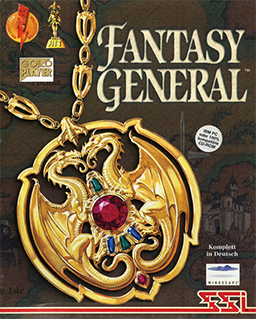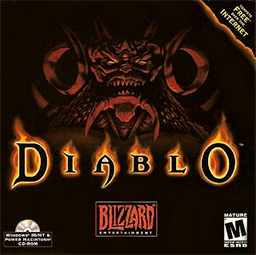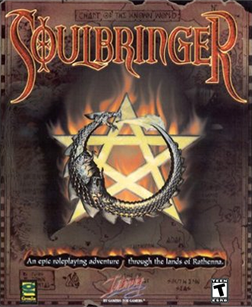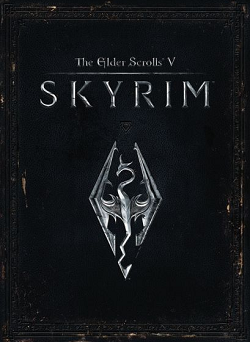
Icewind Dale is a role-playing video game developed by Black Isle Studios and originally published by Interplay Entertainment for Windows in 2000 and by MacPlay for the Macintosh in 2002. The game takes place in the Dungeons & Dragons Forgotten Realms campaign setting and the region of Icewind Dale, and uses the 2nd edition ruleset. The story follows a different set of events than those of R. A. Salvatore's The Icewind Dale Trilogy novels: in the game, an adventuring party becomes enlisted as a caravan guard while in Icewind Dale, in the wake of strange events, and eventually discover a plot that threatens the Ten Towns of Icewind Dale and beyond.

Darkstone: Evil Reigns is an action role-playing video game developed by Delphine Software International for Microsoft Windows and PlayStation. In 2014, the French publisher Anuman Interactive launched a remake available on iPad, iPhone and Android, with the cooperation of the original game's author Paul Cuisset.

Master of Magic is a single-player, fantasy turn-based 4X strategy game in which the player plays as a wizard attempting to dominate two linked worlds. From a small settlement, the player manages resources, builds cities and armies, and researches spells, growing an empire and fighting the other wizards.

Nox is an action role-playing game developed and published by Westwood Studios and Electronic Arts in 2000 for Microsoft Windows. It details the story of Jack, a young man from Earth who is pulled into a high fantasy parallel universe and has to defeat the evil sorceress Hecubah and her army of necromancers to return home. Depending on the player's choice of character class at the beginning of the game, the game follows three largely different linear storylines, each leading to its unique ending. In the multiplayer, players can compete against each other in various game modes such as deathmatch and capture the flag, while the freely downloadable expansion pack NoxQuest added a cooperative multiplayer mode. The game was generally well received by critics and the media.

Baldur's Gate II: Shadows of Amn is a role-playing video game developed by BioWare and published by Interplay Entertainment. It is the sequel to Baldur's Gate (1998) and was released for Microsoft Windows in September 2000. Like Baldur's Gate, the game takes place in the Forgotten Realms—a fantasy campaign setting—and is based on the Advanced Dungeons & Dragons 2nd edition rules. Powered by BioWare's Infinity Engine, Baldur's Gate II uses an isometric perspective and pausable real-time gameplay. The player controls a party of up to six characters, one of whom is the player-created protagonist, while the others are certain characters recruited from the game world.

Heroes of Might and Magic III: The Restoration of Erathia is a turn-based strategy game developed by Jon Van Caneghem through New World Computing originally released for Microsoft Windows by The 3DO Company in 1999. Its ports to several computer and console systems followed in 1999–2000. It is the third installment of the Heroes of Might and Magic series.

Etherlords is a series of fantasy turn-based strategy and card-dueling video games for the PC, by Russian developer Nival Interactive. The first game was published November 15, 2001 by Ravensburger Interactive Media under their mature game label Fishtank Interactive. Prior to worldwide release it was released in Russia as Demiurges. It was followed two years later by a sequel, Etherlords II, which was published in Europe by DreamCatcher Interactive and in North America by Strategy First. A third game for the iOS and Android was released in 2014 titled Etherlords. It's a free-to-play game with automated battles.

The Temple of Elemental Evil is a 2003 role-playing video game by Troika Games. It is a remake of the classic Dungeons & Dragons adventure The Temple of Elemental Evil using the 3.5 edition rules. This is the only computer role-playing game to take place in the Greyhawk campaign setting, and the first video game to implement the 3.5 edition rule set. The game was published by Atari, who then held the interactive rights of the Dungeons & Dragons franchise.

Battle Realms is a real-time strategy video game published and released by Crave Entertainment and Ubi Soft in November 2001. It was the first game created by Liquid Entertainment. An expansion pack Battle Realms: Winter of the Wolf was released in November 2002. In 2012, the game was re-released on GOG.com. In 2019, the game was re-released on Steam as Battle Realms: Zen Edition, in its early access state with functioning online multiplayer.

Silver is an action role-playing video game for Microsoft Windows, Dreamcast and Mac OS X, released in 1999. The game was produced by Infogrames initially for Windows, and later for the Dreamcast. The story focuses around a young warrior called David and his quest to retrieve his wife from the clutches of the villain Silver. On his journey he gains a number of followers and visits many different landscapes. The game sold over 400,000 copies.

Darkened Skye is a third-person action-adventure video game developed by Boston Animation. It was released for Microsoft Windows and GameCube in North America in 2002 and the PAL regions in 2003. The game was also packaged with Outlaw Golf. Its title character is a young woman named Skye who lives in a fantasy realm searching for her mother. She can perform magic using Skittles candies as well as use her staff as a melee weapon; her staff becomes an energy weapon when used in conjunction with the Skittles.

Otogi: Myth of Demons, is a 2002 action video game developed by FromSoftware and published by Sega. It was released for the Xbox in Japan in December 2002, by Sega in North America in August 2003, and Europe in September 2003. Otogi follows former executioner Raikoh Minamoto as he attempts to purge the demons that have overrun Japan and restore the Great Seal that kept them at bay. It received positive reviews and was followed by a sequel, Otogi 2: Immortal Warriors, in 2003.

Fantasy General is a fantasy computer wargame published by Strategic Simulations in 1996. Its structure was taken from the game Panzer General with some modifications to the base system. It was the third in the Five Star General series. It allows gaming against other human players by email. It was published on GOG.com in May 2015 with support for Windows, macOS, and Linux after GOG Ltd acquired the copyright to the title.

Hydlide is an action role-playing game developed and published by T&E Soft. It was originally released for the NEC PC-6001 and PC-8801 computers in 1984, in Japan only; ports for the MSX, MSX2, FM-7 and NEC PC-9801 were released the following year.

Tzar: The Burden of the Crown, also known as simply Tzar, is a real-time strategy game for Microsoft Windows published by TalonSoft and developed by the Bulgarian game developer company Haemimont Games. The game was met with moderate success; however, it got mild recognition and audience when it was published as a demo in several gaming magazines.

Dawn of Magic is an action role-playing computer game developed by Russian studio SkyFallen Entertainment and was originally released under the name of Blood Magic by 1C Company on December 16, 2005. The game was released under its western title by Deep Silver in April, 2007 in Europe, and Atari SA in North America on October 16, 2007.

Diablo is an action role-playing video game developed by Blizzard North and released by Blizzard Entertainment in January 1997, and is the first installment in the video game series of the same name.

Soulbringer is a fantasy RPG developed by Gremlin Interactive and published by Interplay Entertainment and Infogrames in 2000. It was later packed and shipped in combination with Interplay's Planescape: Torment.

The Elder Scrolls V: Skyrim is an action role-playing video game developed by Bethesda Game Studios and published by Bethesda Softworks. It is the fifth main installment in The Elder Scrolls series, following The Elder Scrolls IV: Oblivion (2006), and was released worldwide for Microsoft Windows, PlayStation 3, and Xbox 360 on November 11, 2011.

Final Fantasy is a fantasy role-playing video game developed and published by Square in 1987. It is the first game in Square's Final Fantasy series, created by Hironobu Sakaguchi. Originally released for the NES, Final Fantasy was remade for several video game consoles and is frequently packaged with Final Fantasy II in video game collections. The first Final Fantasy story follows four youths called the Warriors of Light, who each carry one of their world's four elemental crystals which have been darkened by the four Elemental Fiends. Together, they quest to defeat these evil forces, restore light to the crystals, and save their world.




















